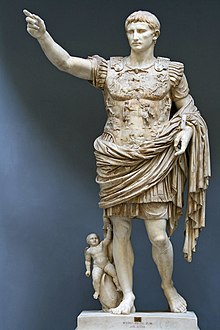statue

A statue or still image is a free-standing sculpture or plastic , usually created by a sculptor , that depicts a person , a divine figure, or an animal. The term statue is usually used for representations in (approximately) natural size and for larger-than-life figures. Significantly smaller figures are called statuettes or figurines . Very large statues are called monumental statues or colossal statues .
The main purpose is symbolic representation.
Special forms are the seated statue (also known as the seated image ) and the equestrian statue (also called the equestrian statue ). Statues differ from busts and herms in that they usually depict the whole body. The still image is also to be distinguished from the gisant ("lying image").
Features of the statue
Many statues are erected as memorials to commemorate a historical event or the life's work of a person. In this respect, statues also symbolize power . In individual cases there may be a more or less strong personality cult , sometimes during the lifetime of the venerated person. This is a form of worship of leaders or founders that protrudes into religious dimensions or replaces religion. The Bismarck cult in the German Reich, the posthumous Lenin cult, and the Stalin cult that began during his lifetime are well-known examples. In recent times we have heard more of personality cults in smaller, dictatorially ruled countries in Asia or Africa, e. B. the cult of Kim Il-Sung in North Korea or the personality cult of Saddam Hussein in Iraq . Until recently, however, the cult of personality was not a rare occurrence in Europe either and was not only observed in dictatorships.
The fall of the statue of living people should seal or anticipate his personal fall (see the fate of the Hussein statue on Firdaus Square in Baghdad during the Iraq war and the reaction of the war opponents with an improvised Bush statue at the demonstration in London 2003).
Germany experienced a real monument boom during the German Empire from 1871 to 1918. A large number of statues and equestrian statues were erected in honor of Kaiser Wilhelm I after his death in 1888 , and a Bismarck cult developed around the Chancellor, who was dismissed in 1890 . By 1914 at least 500 Bismarck monuments of all kinds had been erected: memorial stones, portrait busts, statues and reliefs as well as the Bismarck towers . Statues and busts were mostly to be found in the cities, the Bismarck Towers, which had been built in large numbers since 1898, mostly outside of cities on hills. The best-known Bismarck monuments were the Bismarck National Monument in Berlin and the Bismarck as Roland performing monument in Hamburg .
Statues are also part of public art and are mostly set up in the open air, especially in parks and in front of public buildings. In doing so, the edification of the passers-by is thought of, i.e. an improvement in the general quality of living and life of the people is intended.
Above all, however, the statues erected by public bodies in public space - i.e. in parks, in front of public buildings such as libraries, museums, ministries, etc. - serve political objectives such as generating a certain political awareness. Especially in dictatorships , this form of political staging is intended to achieve the veneration of the person represented with the help of the statue in order to stabilize rule . Statues are often erected on heights or high pedestals in order to induce the viewer to “look up”. This type of political staging is not limited to dictatorships: In the more democratic Western European states, but also in the USA and Japan , we can observe the cult of personality in the center of which the representatives of the " nation " - whether distant, ancient ancestors and ancestors ( Hermannsdenkmal in Germany), founding figures ( Bismarck cult), recent representatives from politics and culture as well as symbolic figures - or so-called national heroes. Often it is a pluralistic personality cult, i.e. one related to a large number of people, rather than a personality cult around a single person.
Well-known statues
- See colossal statue
See also
- List of tallest statues
- Sphyrelaton (statue made of metal plates on a wooden core)
- Statue group
- Living statue
literature
- Hans-Walter Hedinger: Bismarck monuments and Bismarck worship. In: Ekkehard Mai , Stephan Waetzoldt (ed.): Art administration, building and monument policy in the Empire (= art, culture and politics in the German Empire. Vol. 1). Mann, Berlin 1981, ISBN 3-7861-1321-1 , pp. 277-314.
- Thomas Nipperdey : National Idea and National Monument in Germany in the 19th Century. In: Historical magazine . Vol. 206, 1968, pp. 529-585.
- Volker Plagemann : Bismarck monuments. In: Hans-Ernst Mittig , Volker Plagemann (Hrsg.): Monuments in the 19th century. Interpretation and criticism (= studies on the art of the nineteenth century. Vol. 20). Prestel, Munich 1972, ISBN 3-7913-0349-X , pp. 217-252.
- Emil Reisch : Ἀνδριάς . In: Paulys Realencyclopadie der classischen Antiquity Science (RE). Volume I, 2, Stuttgart 1894, Col. 2141.

